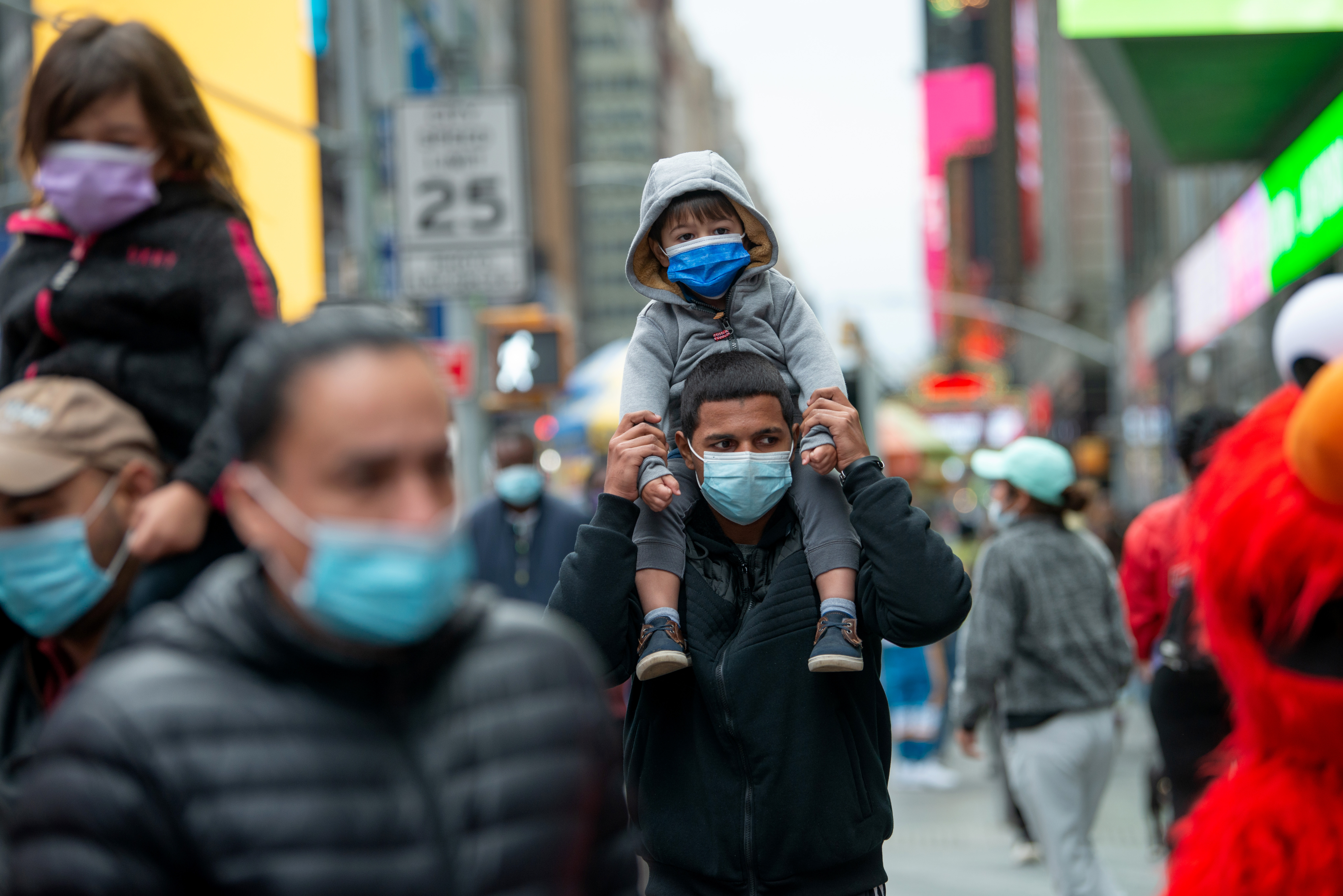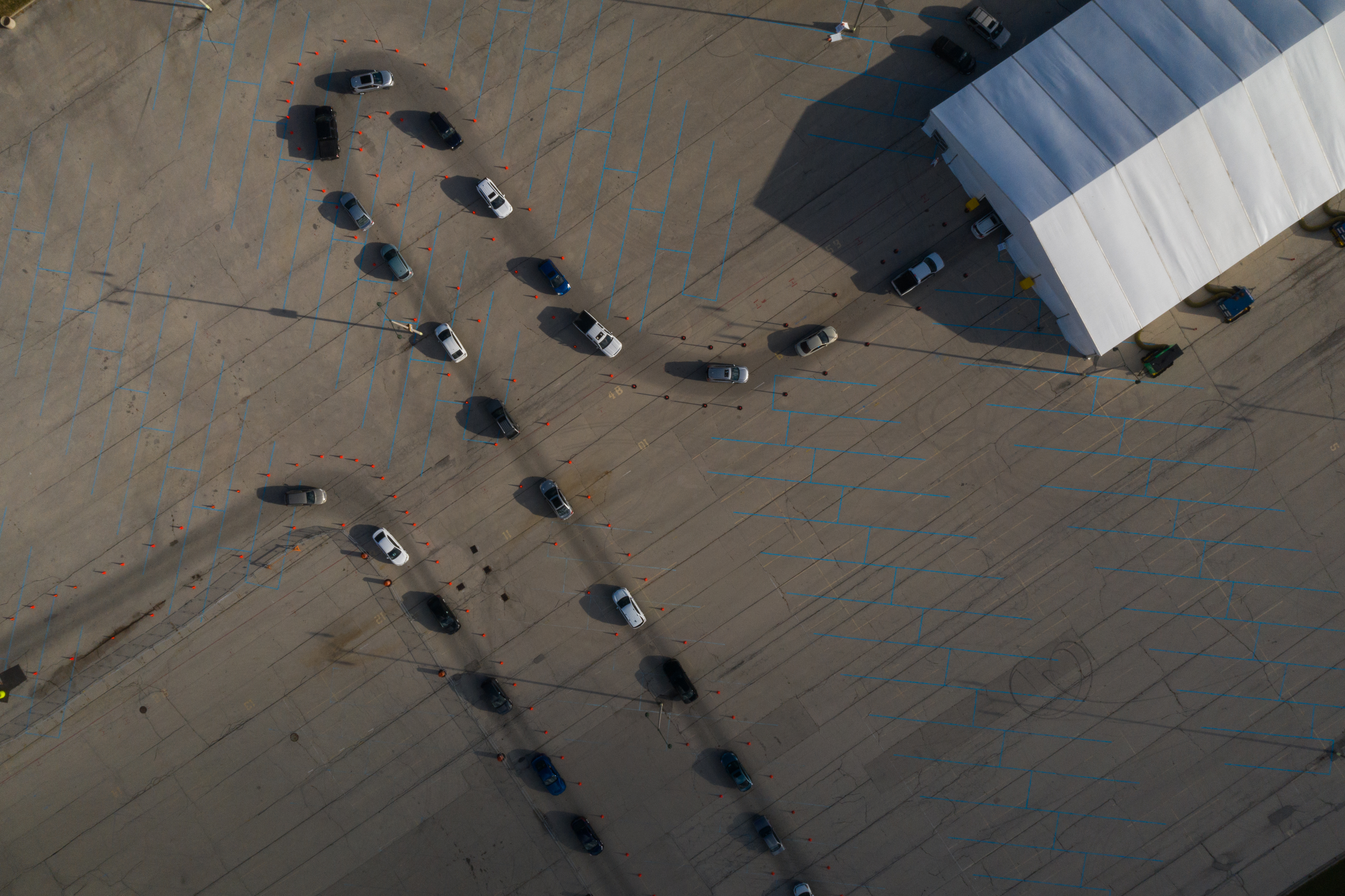There were 144,305 newly reported COVID-19 cases in the United States on Wednesday, according to an NBC News tally, beating the previous record of 133,819 cases reported on Monday.
Wednesday was the eighth day in a row with over 100,000 cases reported. There were 1,528 deaths reported Wednesday.
Meanwhile, the U.S. hit a record number of coronavirus hospitalizations Tuesday, according to the COVID Tracking Project, amid a nationwide surge of infections that shows no signs of slowing.
Hospitalizations across the country reached 61,964 Tuesday just as an NBC News analysis found the number of new U.S. cases for the three-week period ending Monday nearly doubled to 1.9 million from the previous 21-day tally of 1.07 million. If this trend continues at that rate the U.S. could have 13.6 million cases by Nov. 30 and 19.9 million cases by Dec. 21.
The new wave appears bigger and more widespread than the surges that happened in the spring and summer — and threatens to be worse. But experts say there are also reasons to think the nation is better able to deal with the virus this time around.
"We’re definitely in a better place" when it comes to improved medical tools and knowledge, said William Hanage, a Harvard University infectious-disease researcher.
Newly confirmed infections in the U.S. are running at all-time highs of well over 100,000 per day, pushing the total to more than 10 million.
Wisconsin on Tuesday reported 7,073 new cases and 66 deaths overnight, both dismal new records for the state. Ohio also set a new daily record Monday with 6,508 new cases. So did Michigan, with 6,473 new cases Tuesday.
And there has been a surge of new COVID-19 infections in nursing homes after a seven week decline, particularly in the Midwest where the number of deaths is ticking upward, as well, the American Health Care Association and the National Center for Assisted Living reported Tuesday.
Deaths — a lagging indicator, since it takes time for people to get sick and die — are climbing again, reaching an average of more than 930 a day.
Hospitals are getting slammed. And unlike the earlier outbreaks, this one is not confined to a region or two.
"The virus is spreading in a largely uncontrolled fashion across the vast majority of the country," said Dr. William Schaffner, an infectious-disease expert at Vanderbilt University.
Governors made increasingly desperate pleas for people to take the fight against the virus more seriously.
In an unusual prime-time speech hours after Wisconsin set new records for infections and deaths, Democratic Gov. Tony Evers announced that he was advising people to stay in their houses and businesses to allow people to work remotely, require masks and limit the number of people in stores and offices.
Minnesota Gov. Tim Walz, a Democrat, ordered bars and restaurants to close at 10 p.m., and Iowa Gov. Kim Reynolds, a Republican, said she will require masks at indoor gatherings of 25 or more people, inching toward more stringent measures after months of holding out.
While deaths are still well below the U.S. peak of about 2,200 per day back in April, some researchers estimate the nation's overall toll will hit about 400,000 by Feb. 1, up from the more than 241,000 currently reported.
But there is also some good news.
Doctors now better know how to treat severe cases, meaning higher percentages of the COVID-19 patients who go into intensive care units are coming out alive. Patients have the benefit of new treatments, namely remdesivir, the steroid dexamethasone and an antibody drug that won emergency-use approval from the Food and Drug Administration on Monday. Also, testing is more widely available.
In addition, a vaccine appears to be on the horizon, perhaps around the end of the year, with Pfizer this week reporting early results showing that its experimental shots are a surprising 90% effective at preventing the disease.
And there's a change pending in the White House, with President-elect Joe Biden vowing to rely on a highly respected set of medical advisers and carry out a detailed coronavirus plan that experts say includes the kind of measures that will be necessary to bring the surge under control.
Biden pledged during the campaign to be guided by science, make testing free and widely available, hire thousands of health workers to undertake contact-tracing, and instruct the Centers for Disease Control and Prevention to provide clear, expert advice.
On Monday, Biden announced a coronavirus advisory board that will help him tackle the pandemic as soon as he takes office in January. The board will be led by former Surgeon General Dr. Vivek Murthy, former Food and Drug Administration Commissioner David Kessler and Yale University public health care expert Dr. Marcella Nunez-Smith.
"We are already seeing encouraging signs from President-elect Biden with regard to his handling of COVID-19," said Dr. Kelly Henning, a veteran epidemiologist who heads the Bloomberg Philanthropies’ public health programs.
"I am relieved to see he’s already put some of the smartest scientific minds on his new coronavirus task force and that they are acting urgently to try and get the pandemic under control as quickly as possible," Henning said.
While the first surge in the Northeast caught many Americans unprepared and cut an especially deadly swath through nursing homes, the second crest along the nation's Southern and Western rim was attributed mostly to heedless behavior, particularly among young adults over Memorial Day and July Fourth, and hot weather that sent people indoors, where the virus spreads more easily.
The fall surge similarly has been blamed largely on cold weather driving people inside and disdain for masks and social distancing, stoked by President Donald Trump and other politicians.
Even in parts of the country that have been through coronavirus surges before, "you see people breaking out of it" and letting their guard down, Schaffner said.
"There really is COVID fatigue that is blending into COVID annoyance," he said.
The short-term outlook is grim, with colder weather and Thanksgiving, Christmas and New Year's ahead. Generations of family members gathering indoors for meals for extended periods “is not a recipe for anything good,” Hanage said.
Other factors could contribute to the spread of the virus in the coming weeks: Last weekend saw big street celebrations and protests over the election. On Saturday night, an upset victory by Notre Dame's football team sent thousands of students swarming onto the field, many without masks.
Coronavirus Pandemic Coverage
Meanwhile, the next two months will see a lame-duck Congress and a president who might be even less inclined than before to enact disease-control measures. Those voted out of office or no longer worried about reelection for at least two more years, "are not going to be motivated to do a fantastic job," Hanage said.
Experts are increasingly alarmed about the virus’s resurgence in places like Massachusetts, which has seen a dramatic rise in cases since Labor Day, blamed largely on young people socializing.
Republican Gov. Charlie Baker is warning that the health care system could become overwhelmed this winter, and he recently ordered restaurants to stop table service, required many businesses to close by 9:30 p.m., and instructed residents to stay home between 10 p.m. and 5 a.m.
Brooke Nichols, a professor and infectious-disease mathematical modeler at Boston University School of Public Health, said the governor’s actions don’t go far enough.
"Right now because of the exponential growth, throw the kitchen sink at this, and then you can do it for not as long," Nichols said.
Elsewhere, political leaders in a number of newer coronavirus hot spots are doing less. In hard-hit South Dakota, Gov. Kristi Noem has made it clear she will not institute a mask requirement and has voiced doubt in health experts who say face coverings prevent infections from spreading.
Even higher case and death rates have been seen in North Dakota, where many people have refused to wear masks. Gov. Doug Burgum has pleaded with people to do so, and praised local towns and cities that have mandated masks. But he has avoided requiring masks himself.
Both Noem and Burgum are Republicans and have taken positions in line with those of the president.
"It would be simplistic to say it’s a red-vs.-a-blue experience, but it does kind of go along party lines of whether people took it seriously, tried to prevent it and took painful measures, versus those who said, ‘Let it rip,'" said Dr. Howard Markel, a public health historian at the University of Michigan.
Associated Press writer Alanna Durkin Richer in Boston contributed to this report.
The Associated Press Health and Science Department receives support from the Howard Hughes Medical Institute’s Department of Science Education. The AP is solely responsible for all content.



